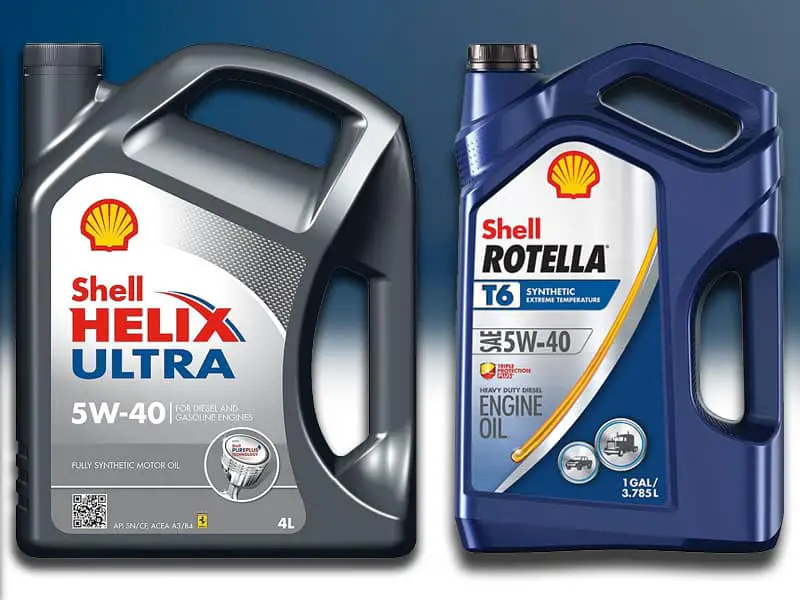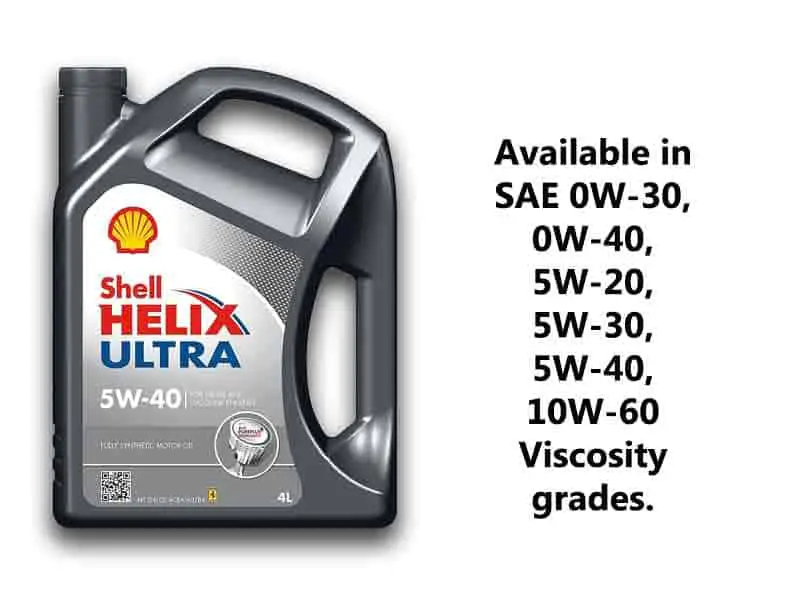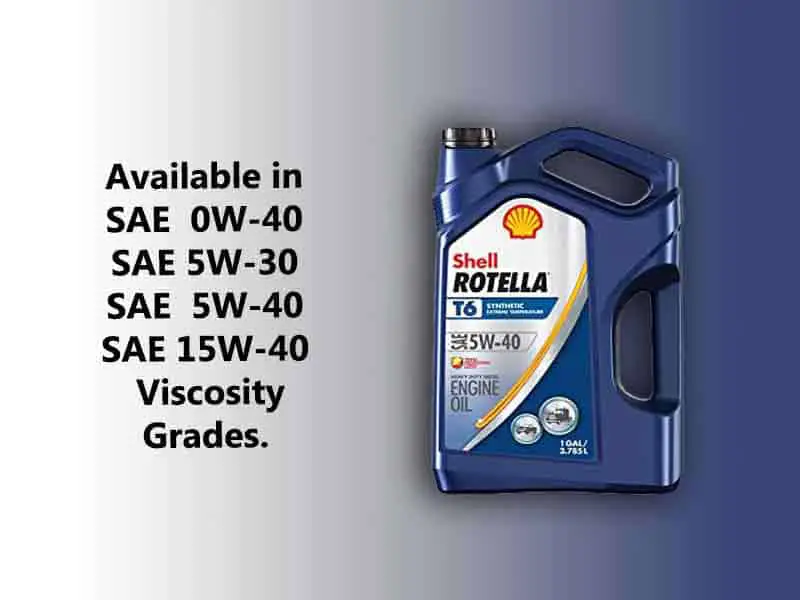Shell Helix Ultra is a fully synthetic oil made for both gasoline and diesel high-performance engines. It has active cleaning Technology for reducing the sludge build-up. It provides 30% more long-term oxidation stability compared to the other motor oils. It is known for its remarkable Viscosity Index and special synthetic base oils, which reduces its volatility. This oil reduces engine vibration and noises, providing smoother rides.
Compare Shell Helix Ultra with others:

Shell Rotella T6 is also a fully synthetic motor oil made for heavy-duty vehicles having both diesel and gasoline engines. It specializes in reducing the oil consumption of the vehicle, improving the fuel economy up to 2.8% compared to other oils of the same brand. Its other exceptional characteristics are high-temperature oil breakdown resistance and exceptionally low-temperature oil performance.
Check out the Comparison: Rotella T4 vs T5 vs T6
Table of Contents
Comparison Table
| Specifications | Shell Helix Ultra | Rotella T6 |
| Oil Type | Fully Synthetic | Fully Synthetic |
| Engine Type | Both Gasoline and Diesel | Both Gasoline and Diesel |
| Available viscosity grades | SAE 0W – 30, 0W – 40, 5W – 20, 5W – 30, 5W – 40, 10W-60 | SAE 0W-40, 5W-30, 5W-40, 15W-40 |
| ILSAC | GF-5 | GF-6A |
| API | SN/CF | CJ-4/SN/CK-4/CI-4Plus/CI-4/CH-4 |
| Cost (per liter) | 3$ | 5.15$ |
| Oil change frequency (Kms) | 10000-12000 | Up to 19000 |
| Additives | Anti-wear, Detergents, viscosity modifiers | Anti-wear, Detergents, Friction modifiers |
| ACEA | A3/B3 and A3/B4 | E6 |
Catalytic Converter Performance Comparison
The catalytic converter can be damaged by zinc and phosphorus compounds which are used as anti-wear additives inside the oil. When the oil is overheated these zinc and phosphorous compounds turn into ashes, poisoning the converter. The quantity of these compounds is tested higher in T6, which ultimately damages the catalytic converter much more in comparison with Ultra.
| Oils in Comparison (5W-30 Grade oil) | Zinc Concentration (ppm) | Phosphorus Concentration (ppm) |
| Shell Helix Ultra | 780 | 655 |
| Shell Rotella T6 | 872 | 782 |
Sludge Buildup Reduction Comparison
Sludge is formed because of the oxidation of lubricant at a high temperature which breaks away and combines with dirt to form carbon. This carbon in presence of gas, water, and coolant forms sludge that hinders the flow of oil by blocking the pipes and valves. Detergents are present in oils for reducing this sludge built up and they also break down the already present sludge. Commonly Sodium, Magnesium, and Calcium are used as detergents in motor oil. Upon testing, their quantity was found higher in T6 in comparison to Ultra. This means that it will perform better at reducing the sludge than its counterpart.
| Oils in Comparison (5W-30 Grade oil) | Sodium Concentration (ppm) | Magnesium Concentration (ppm) | Calcium Concentration (ppm) |
| Shell Helix Ultra | 0 | 11 | 1651 |
| Shell Rotella T6 | 5 | 800 | 1253 |
Comparison of Oil Burn off Protection
Two factors are influencing the oil burn-off rate, one is temperature and the other is the volatility of that oil. An oil that is not efficient in maintaining temperature stability will get vaporized quickly due to the higher temperature evaporating it and the second reason is the Flashpoint. It is the point where the vapors of a certain oil can produce non-continuous ignition, if interacted with a spark. The liquid which vaporizes slowly will reach its flashpoint at a higher temperature compared to the liquid which vaporizes quickly. The flashpoint of T6 was tested to be higher than that of Ultra, meaning that it is less volatile and will burn off much slower than its competitor.
| Oils in Comparison (5W-30 Grade oil) | Flash Point Temperatures (Degrees Celsius) |
| Shell Helix Ultra | 215 |
| Shell Rotella T6 | 239 |
Comparison of Engine Wear off Protection
There are metal parts in engines that could strike each other and cause wear and tear. To avoid this scenario the lubricating oil with anti-wear additives is used. These anti-wear additives form a layer around the metal parts and reduce the friction between them. A higher number of these additives ensures better protection against the engine wear off, by forming a thicker layer around the metal parts, further reducing the friction in between them. After testing it was found that T6 has a higher number of anti-wear additives like Zinc and Phosphorus and they were enforced by Boron and Molybdenum which act as a friction modifier, ensuring better performance of T6 in terms of engine wear off protection in comparison with the Ultra.
| Oils in Comparison (5W-30 Grade oil) | Zinc Concentration (ppm) | Phosphorus Concentration (ppm) | Boron Concentration (ppm) | Molybdenum Concentration (ppm) |
| Shell Helix Ultra | 780 | 655 | 41 | 0 |
| Shell Rotella T6 | 872 | 782 | 201 | 3 |
Viscosity Comparison

To compare the performance of any oil we must determine its kinematic viscosity which is the viscosity divided by the density of the oil at a certain temperature, showing its internal resistance to flow and shear due to gravity. Higher kinematic viscosity means that the momentum can easily be transferred between the layers and particles of that fluid. At a lower temperature kinematic viscosity of T6 is higher than Ultra which means it will perform better. As the temperature increases to a higher point, it was found that the kinematic viscosity of Ultra is a little higher than T6, indicating that Ultra is somewhat better at higher temperatures. This change in kinematic viscosities when going from a lower temperature to a higher temperature is known as Viscosity Index. The Viscosity Index of Ultra is higher than T6 because it was better at retaining its viscosity at a higher temperature even though its viscosity was lower at a low temperature in comparison. In winter where the room temperature is minus degrees Celsius, the oil with a lower pour point temperature is considered best. Pour point is the temperature, below which the liquid will not flow under the influence of gravity (it will freeze). Since the pour point temperature of T6 is lower than its peer that’s why it is more suitable in winter weather comparatively.

| Oils in Comparison (5W-30 Grade oil) | Kinematic Viscosity @ 40 o C | Kinematic Viscosity @ 100 o C | Viscosity index (VI) | Pour point (Degrees Celsius) |
| Shell Helix Ultra | 68.2 cSt | 12.2 cSt | 162 | -39 |
| Shell Rotella T6 | 75 cSt | 12.1 cSt | 159 | -48 |
Oil Change Frequency Comparison
Different factors contribute to deciding the frequency of oil change. Among which one of the major factors is Total base number, which is defined as the total amount of base available inside the oil which is required to neutralize the organic and non-organic acids produced during the combustion process. A higher number of TBN indicated that the oil has a higher concentration of KOH base available, and it can neutralize the acids for a long time and vice versa. Therefore, TBN decreases gradually with time but when considering the TBN in ultra and T6 motor oils it is found that the TBN of T6 is almost double compared to that of Ultra. This results in an oil change interval of almost 19,000 km for T6 whereas the oil change interval of Ultra is 10,000 to 12,000 km much shorter than its counterpart.
| Oils in Comparison (5W-30 Grade oil) | TBN (Total Base Number) mg/g KOH |
| Shell Helix Ultra | 5.85 |
| Shell Rotella T6 | 11.84 |
Cost Comparison
Ultra is available at a price tag of three US Dollars per liter while the T6 can be bought for 5.15 US Dollars per liter. The price of T6 is significantly higher due to its enhanced performance made possible by the advanced additives added inside it. Its ILSAC and API ratings are also higher, and it provides longer oil change intervals in a wide range of oil grades, making it more attractive than its competitor.
Quick Summary
- Both Ultra and T6 are fully synthetic oils.
- Ultra allows better catalytic converter performance due to the lower amount of zinc and phosphorus compounds present inside it.
- T6 is effective at removing sludge and provides higher protection against sludge buildup.
- The Flash point of T6 is higher, hence its volatility is lower in comparison.
- Anti-wear additives and friction modifiers are present at a higher quantity in T6 ensuring better performance in terms of engine wear-off protection.
- At freezing temperature T6 performs better due to its lower pour point.
- At 40 o C, T6 performs better due to higher kinematic viscosity.
- But at the 100 o C temperature, Ultra takes the lead in terms of kinematic viscosity due to the lower Viscosity Index of T6.
- Higher TBN provides longer oil change intervals to the T6 oil users.
- Helix Ultra is a little lower priced than its counterpart.
- The overall performance and the fuel economy of T6 are found to be better than Ultra.